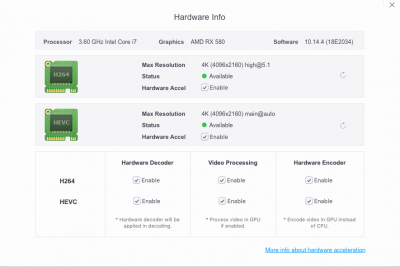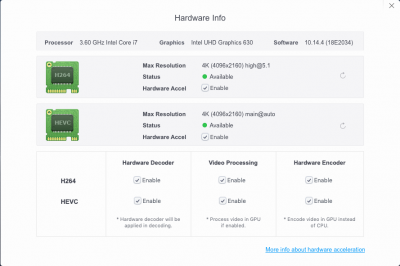- Joined
- Mar 4, 2019
- Messages
- 73
- Motherboard
- Designare Z390
- CPU
- i7-9700K
- Graphics
- RX580 Pulse
Hey @CaseySJ,
I haven't been experiencing any weird finder issues at all, so it must have been an anomaly.
Recently, I switched to the special 10.14.4 build and iMac 19.1 SMBIOS. While I totally understand that you can't provide support for switching to a different SMBIOS, I just wanted to ask: What does the "SSDT-Z390-DESIGNARE-RX580-V2" provided in your post installation package do?
When I have that SSDT in my EFI folder, VideoProc shows "Graphics" as AMD RX580 (which isn't right for headless mode). When I remove the SSDT and reboot, VideoProc correctly shows Intel UHD Graphics 630. In both cases, testing HVEC and H264 produced "green" results in VideoProc. Check out the attached screenshots below.
I haven't been experiencing any weird finder issues at all, so it must have been an anomaly.
Recently, I switched to the special 10.14.4 build and iMac 19.1 SMBIOS. While I totally understand that you can't provide support for switching to a different SMBIOS, I just wanted to ask: What does the "SSDT-Z390-DESIGNARE-RX580-V2" provided in your post installation package do?
When I have that SSDT in my EFI folder, VideoProc shows "Graphics" as AMD RX580 (which isn't right for headless mode). When I remove the SSDT and reboot, VideoProc correctly shows Intel UHD Graphics 630. In both cases, testing HVEC and H264 produced "green" results in VideoProc. Check out the attached screenshots below.



